Case Study: Macroeconomic Challenges in the US Economy
VerifiedAdded on 2022/10/19
|17
|2882
|5
Case Study
AI Summary
This case study delves into the macroeconomic challenges of unemployment and inflation within the US economy. It begins with an executive summary, followed by an introduction that defines these key economic issues and their implications. The paper presents and analyzes data from 2009 to 2019, including unemployment rates, inflation rates, GDP growth, and real wage trends, with a focus on youth unemployment and disparities within Black and Hispanic communities. The analysis examines the downward trend in unemployment, the impact of inflation, and wage stagnation. The study identifies high youth unemployment and social discrimination in the labor market as critical issues. The reflection section discusses the impact of government policies, and suggests solutions like balanced employment protection, monetary policies, and addressing non-measurable factors to mitigate discrimination. The paper concludes with a discussion on the need for targeted interventions to promote economic well-being.
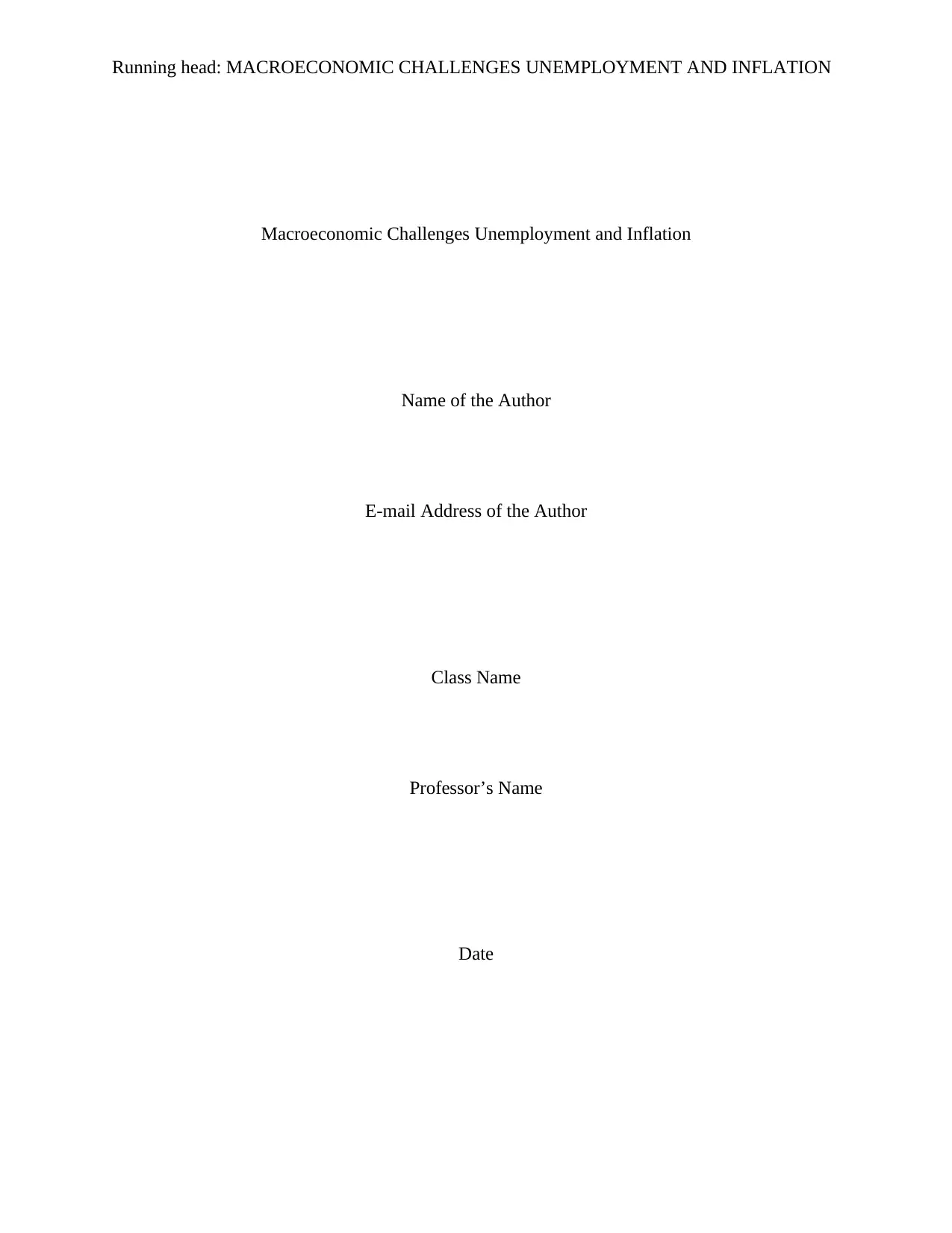
Running head: MACROECONOMIC CHALLENGES UNEMPLOYMENT AND INFLATION
Macroeconomic Challenges Unemployment and Inflation
Name of the Author
E-mail Address of the Author
Class Name
Professor’s Name
Date
Macroeconomic Challenges Unemployment and Inflation
Name of the Author
E-mail Address of the Author
Class Name
Professor’s Name
Date
Paraphrase This Document
Need a fresh take? Get an instant paraphrase of this document with our AI Paraphraser
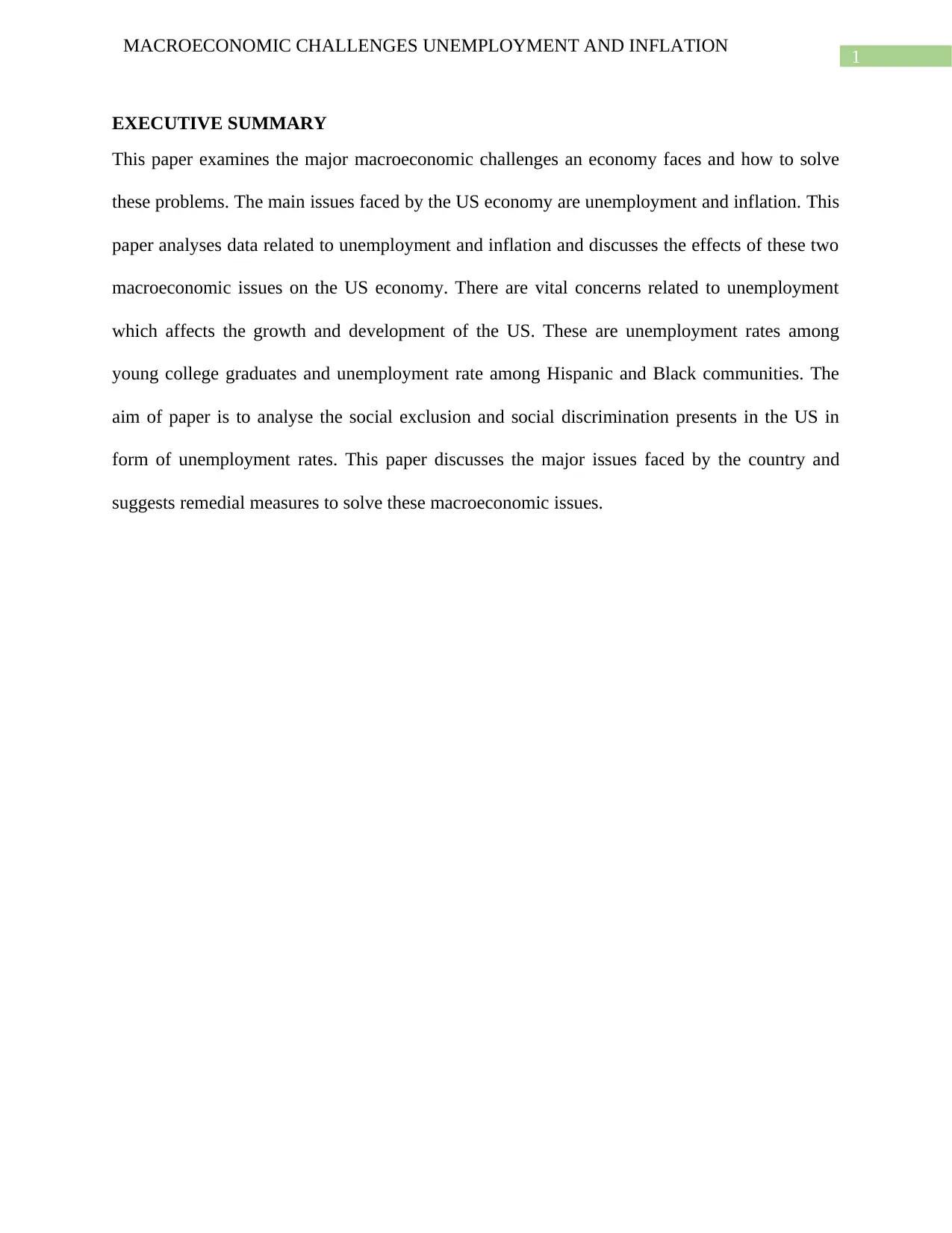
1
MACROECONOMIC CHALLENGES UNEMPLOYMENT AND INFLATION
EXECUTIVE SUMMARY
This paper examines the major macroeconomic challenges an economy faces and how to solve
these problems. The main issues faced by the US economy are unemployment and inflation. This
paper analyses data related to unemployment and inflation and discusses the effects of these two
macroeconomic issues on the US economy. There are vital concerns related to unemployment
which affects the growth and development of the US. These are unemployment rates among
young college graduates and unemployment rate among Hispanic and Black communities. The
aim of paper is to analyse the social exclusion and social discrimination presents in the US in
form of unemployment rates. This paper discusses the major issues faced by the country and
suggests remedial measures to solve these macroeconomic issues.
MACROECONOMIC CHALLENGES UNEMPLOYMENT AND INFLATION
EXECUTIVE SUMMARY
This paper examines the major macroeconomic challenges an economy faces and how to solve
these problems. The main issues faced by the US economy are unemployment and inflation. This
paper analyses data related to unemployment and inflation and discusses the effects of these two
macroeconomic issues on the US economy. There are vital concerns related to unemployment
which affects the growth and development of the US. These are unemployment rates among
young college graduates and unemployment rate among Hispanic and Black communities. The
aim of paper is to analyse the social exclusion and social discrimination presents in the US in
form of unemployment rates. This paper discusses the major issues faced by the country and
suggests remedial measures to solve these macroeconomic issues.
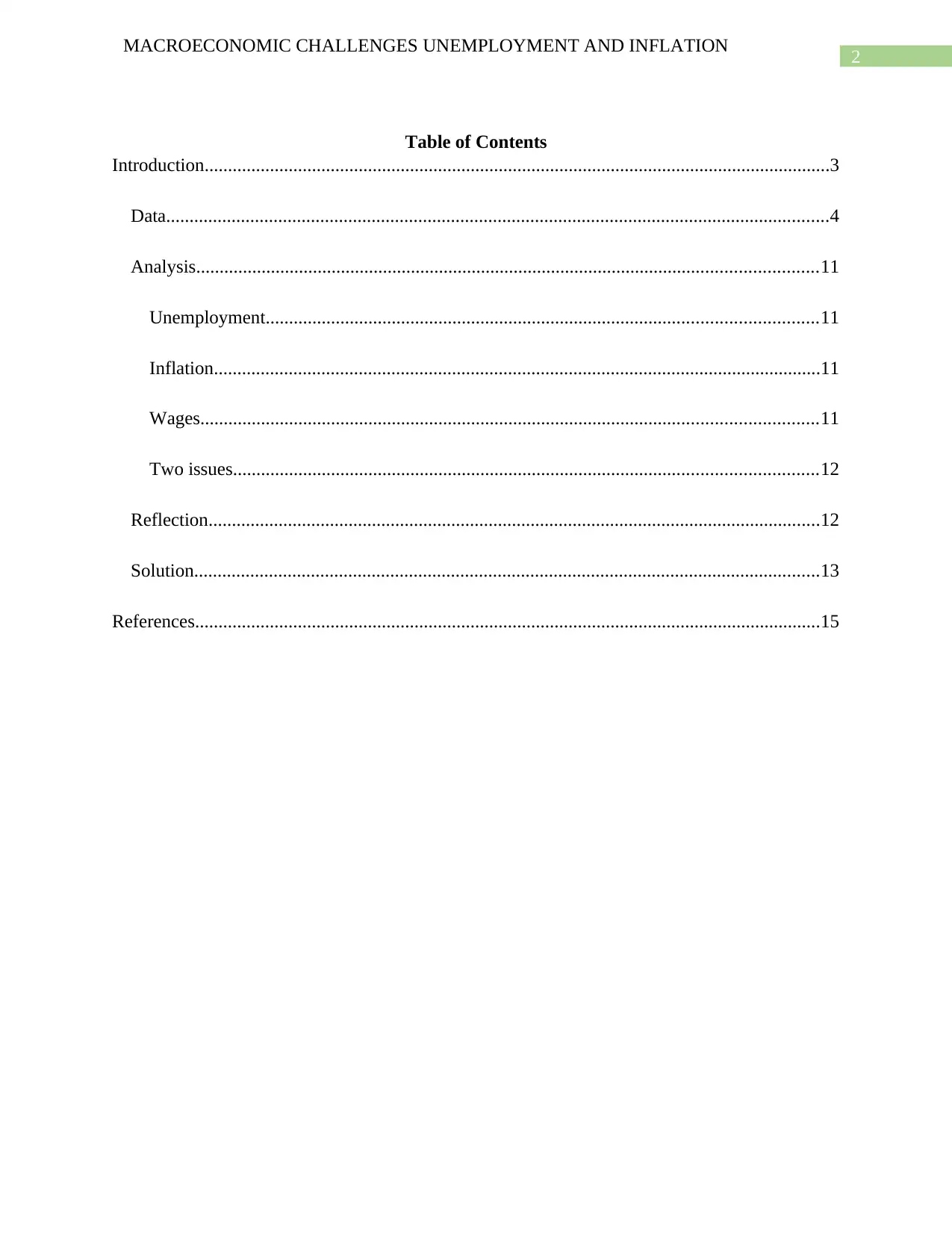
2
MACROECONOMIC CHALLENGES UNEMPLOYMENT AND INFLATION
Table of Contents
Introduction......................................................................................................................................3
Data..............................................................................................................................................4
Analysis.....................................................................................................................................11
Unemployment......................................................................................................................11
Inflation..................................................................................................................................11
Wages....................................................................................................................................11
Two issues.............................................................................................................................12
Reflection...................................................................................................................................12
Solution......................................................................................................................................13
References......................................................................................................................................15
MACROECONOMIC CHALLENGES UNEMPLOYMENT AND INFLATION
Table of Contents
Introduction......................................................................................................................................3
Data..............................................................................................................................................4
Analysis.....................................................................................................................................11
Unemployment......................................................................................................................11
Inflation..................................................................................................................................11
Wages....................................................................................................................................11
Two issues.............................................................................................................................12
Reflection...................................................................................................................................12
Solution......................................................................................................................................13
References......................................................................................................................................15
⊘ This is a preview!⊘
Do you want full access?
Subscribe today to unlock all pages.

Trusted by 1+ million students worldwide
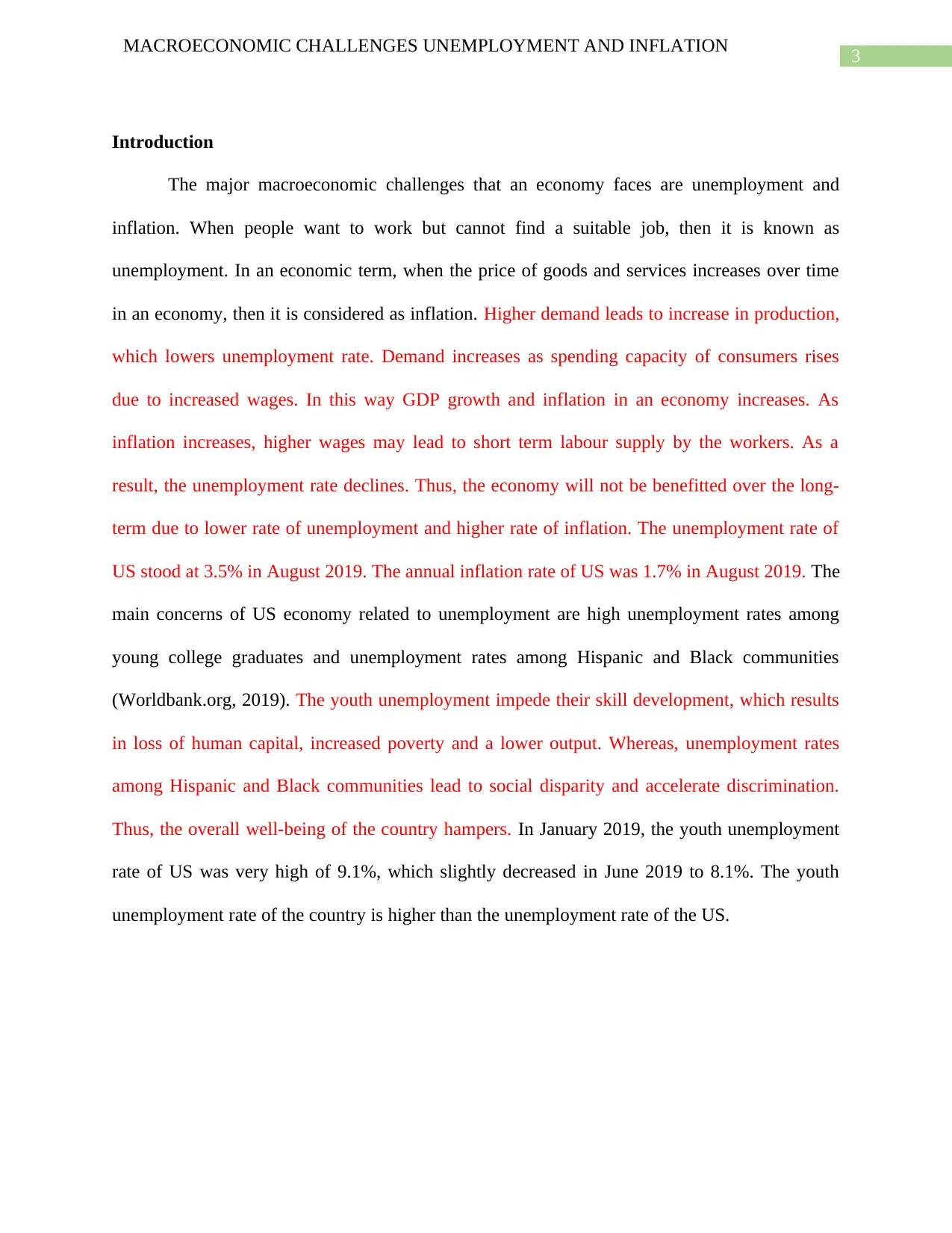
3
MACROECONOMIC CHALLENGES UNEMPLOYMENT AND INFLATION
Introduction
The major macroeconomic challenges that an economy faces are unemployment and
inflation. When people want to work but cannot find a suitable job, then it is known as
unemployment. In an economic term, when the price of goods and services increases over time
in an economy, then it is considered as inflation. Higher demand leads to increase in production,
which lowers unemployment rate. Demand increases as spending capacity of consumers rises
due to increased wages. In this way GDP growth and inflation in an economy increases. As
inflation increases, higher wages may lead to short term labour supply by the workers. As a
result, the unemployment rate declines. Thus, the economy will not be benefitted over the long-
term due to lower rate of unemployment and higher rate of inflation. The unemployment rate of
US stood at 3.5% in August 2019. The annual inflation rate of US was 1.7% in August 2019. The
main concerns of US economy related to unemployment are high unemployment rates among
young college graduates and unemployment rates among Hispanic and Black communities
(Worldbank.org, 2019). The youth unemployment impede their skill development, which results
in loss of human capital, increased poverty and a lower output. Whereas, unemployment rates
among Hispanic and Black communities lead to social disparity and accelerate discrimination.
Thus, the overall well-being of the country hampers. In January 2019, the youth unemployment
rate of US was very high of 9.1%, which slightly decreased in June 2019 to 8.1%. The youth
unemployment rate of the country is higher than the unemployment rate of the US.
MACROECONOMIC CHALLENGES UNEMPLOYMENT AND INFLATION
Introduction
The major macroeconomic challenges that an economy faces are unemployment and
inflation. When people want to work but cannot find a suitable job, then it is known as
unemployment. In an economic term, when the price of goods and services increases over time
in an economy, then it is considered as inflation. Higher demand leads to increase in production,
which lowers unemployment rate. Demand increases as spending capacity of consumers rises
due to increased wages. In this way GDP growth and inflation in an economy increases. As
inflation increases, higher wages may lead to short term labour supply by the workers. As a
result, the unemployment rate declines. Thus, the economy will not be benefitted over the long-
term due to lower rate of unemployment and higher rate of inflation. The unemployment rate of
US stood at 3.5% in August 2019. The annual inflation rate of US was 1.7% in August 2019. The
main concerns of US economy related to unemployment are high unemployment rates among
young college graduates and unemployment rates among Hispanic and Black communities
(Worldbank.org, 2019). The youth unemployment impede their skill development, which results
in loss of human capital, increased poverty and a lower output. Whereas, unemployment rates
among Hispanic and Black communities lead to social disparity and accelerate discrimination.
Thus, the overall well-being of the country hampers. In January 2019, the youth unemployment
rate of US was very high of 9.1%, which slightly decreased in June 2019 to 8.1%. The youth
unemployment rate of the country is higher than the unemployment rate of the US.
Paraphrase This Document
Need a fresh take? Get an instant paraphrase of this document with our AI Paraphraser
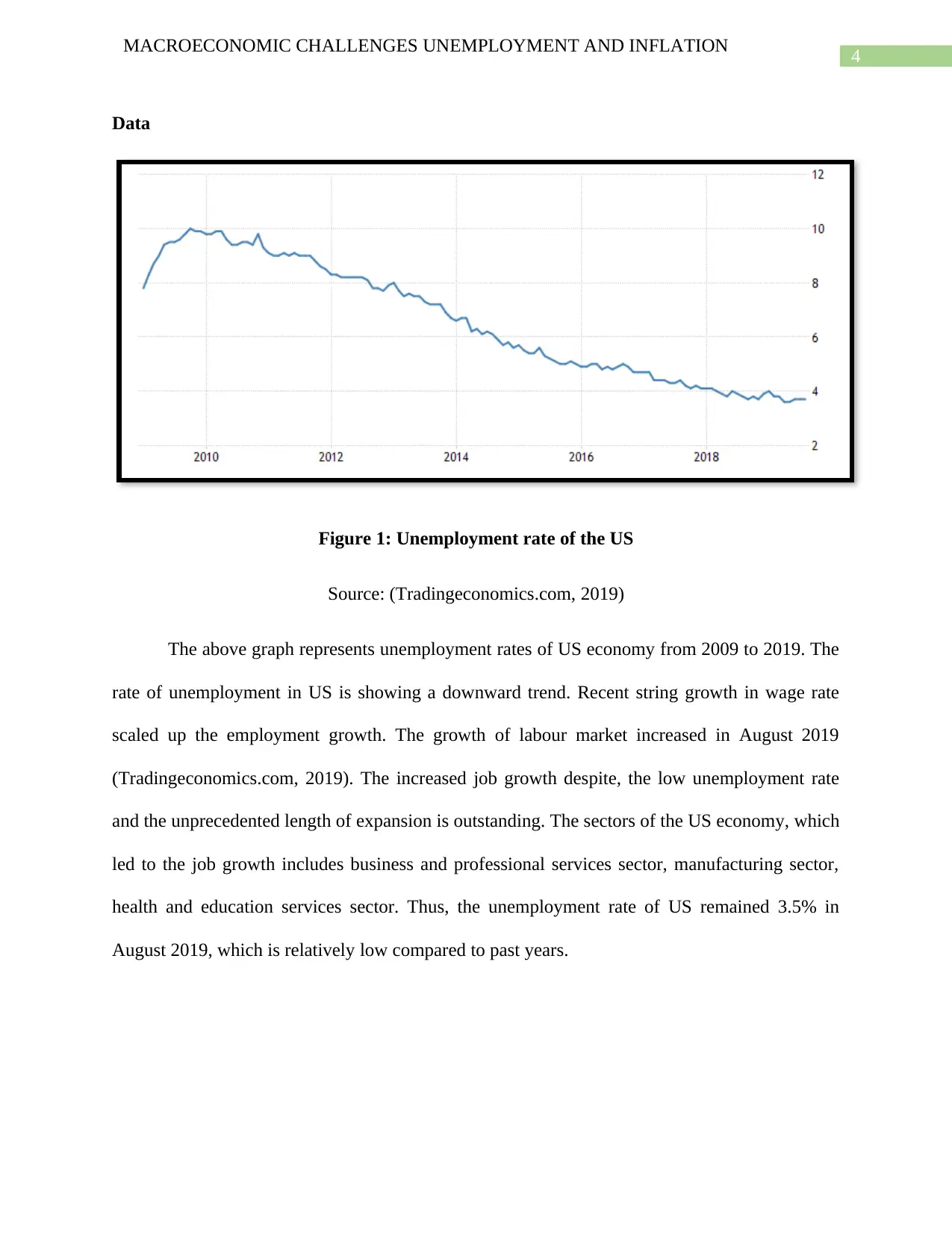
4
MACROECONOMIC CHALLENGES UNEMPLOYMENT AND INFLATION
Data
Figure 1: Unemployment rate of the US
Source: (Tradingeconomics.com, 2019)
The above graph represents unemployment rates of US economy from 2009 to 2019. The
rate of unemployment in US is showing a downward trend. Recent string growth in wage rate
scaled up the employment growth. The growth of labour market increased in August 2019
(Tradingeconomics.com, 2019). The increased job growth despite, the low unemployment rate
and the unprecedented length of expansion is outstanding. The sectors of the US economy, which
led to the job growth includes business and professional services sector, manufacturing sector,
health and education services sector. Thus, the unemployment rate of US remained 3.5% in
August 2019, which is relatively low compared to past years.
MACROECONOMIC CHALLENGES UNEMPLOYMENT AND INFLATION
Data
Figure 1: Unemployment rate of the US
Source: (Tradingeconomics.com, 2019)
The above graph represents unemployment rates of US economy from 2009 to 2019. The
rate of unemployment in US is showing a downward trend. Recent string growth in wage rate
scaled up the employment growth. The growth of labour market increased in August 2019
(Tradingeconomics.com, 2019). The increased job growth despite, the low unemployment rate
and the unprecedented length of expansion is outstanding. The sectors of the US economy, which
led to the job growth includes business and professional services sector, manufacturing sector,
health and education services sector. Thus, the unemployment rate of US remained 3.5% in
August 2019, which is relatively low compared to past years.
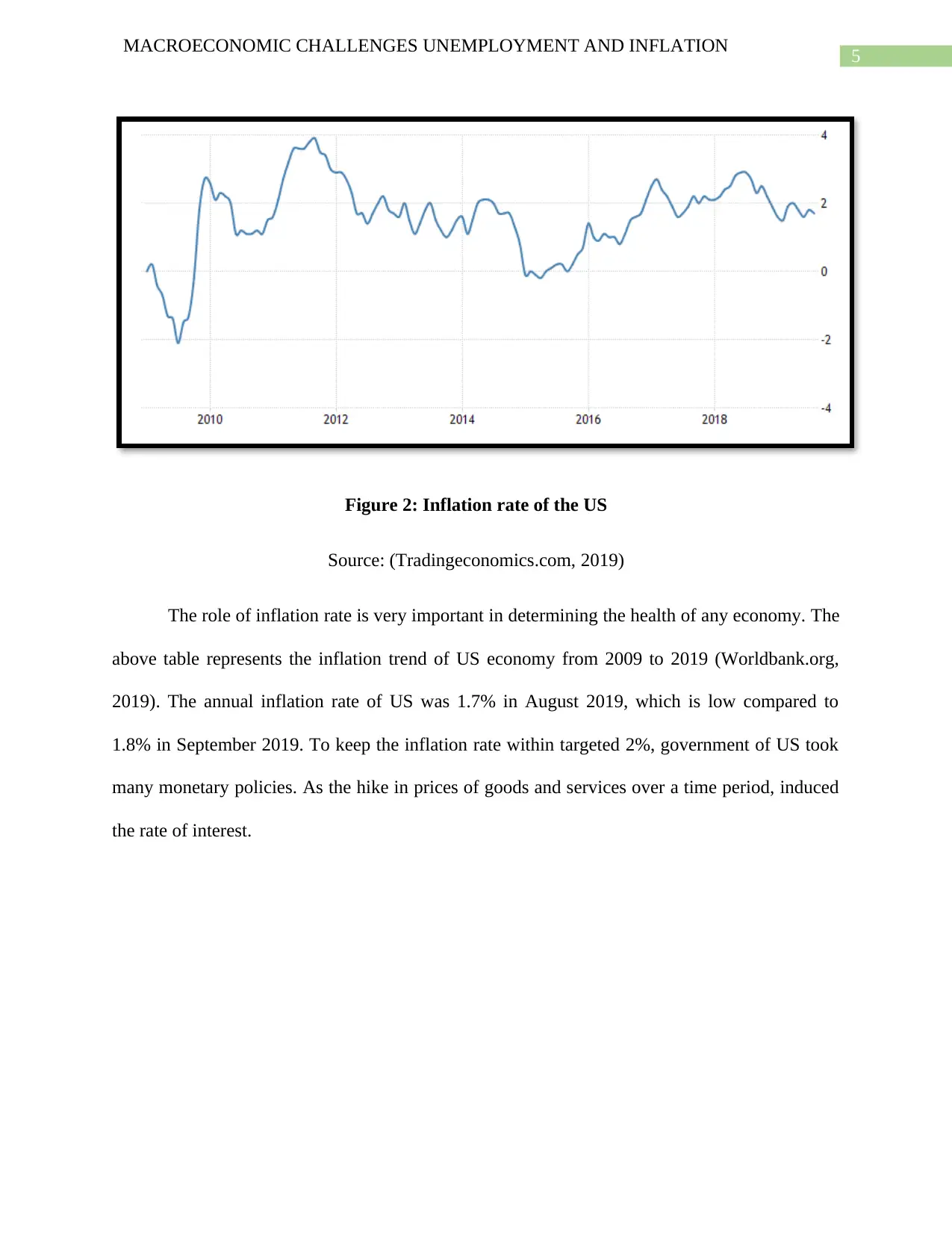
5
MACROECONOMIC CHALLENGES UNEMPLOYMENT AND INFLATION
Figure 2: Inflation rate of the US
Source: (Tradingeconomics.com, 2019)
The role of inflation rate is very important in determining the health of any economy. The
above table represents the inflation trend of US economy from 2009 to 2019 (Worldbank.org,
2019). The annual inflation rate of US was 1.7% in August 2019, which is low compared to
1.8% in September 2019. To keep the inflation rate within targeted 2%, government of US took
many monetary policies. As the hike in prices of goods and services over a time period, induced
the rate of interest.
MACROECONOMIC CHALLENGES UNEMPLOYMENT AND INFLATION
Figure 2: Inflation rate of the US
Source: (Tradingeconomics.com, 2019)
The role of inflation rate is very important in determining the health of any economy. The
above table represents the inflation trend of US economy from 2009 to 2019 (Worldbank.org,
2019). The annual inflation rate of US was 1.7% in August 2019, which is low compared to
1.8% in September 2019. To keep the inflation rate within targeted 2%, government of US took
many monetary policies. As the hike in prices of goods and services over a time period, induced
the rate of interest.
⊘ This is a preview!⊘
Do you want full access?
Subscribe today to unlock all pages.

Trusted by 1+ million students worldwide
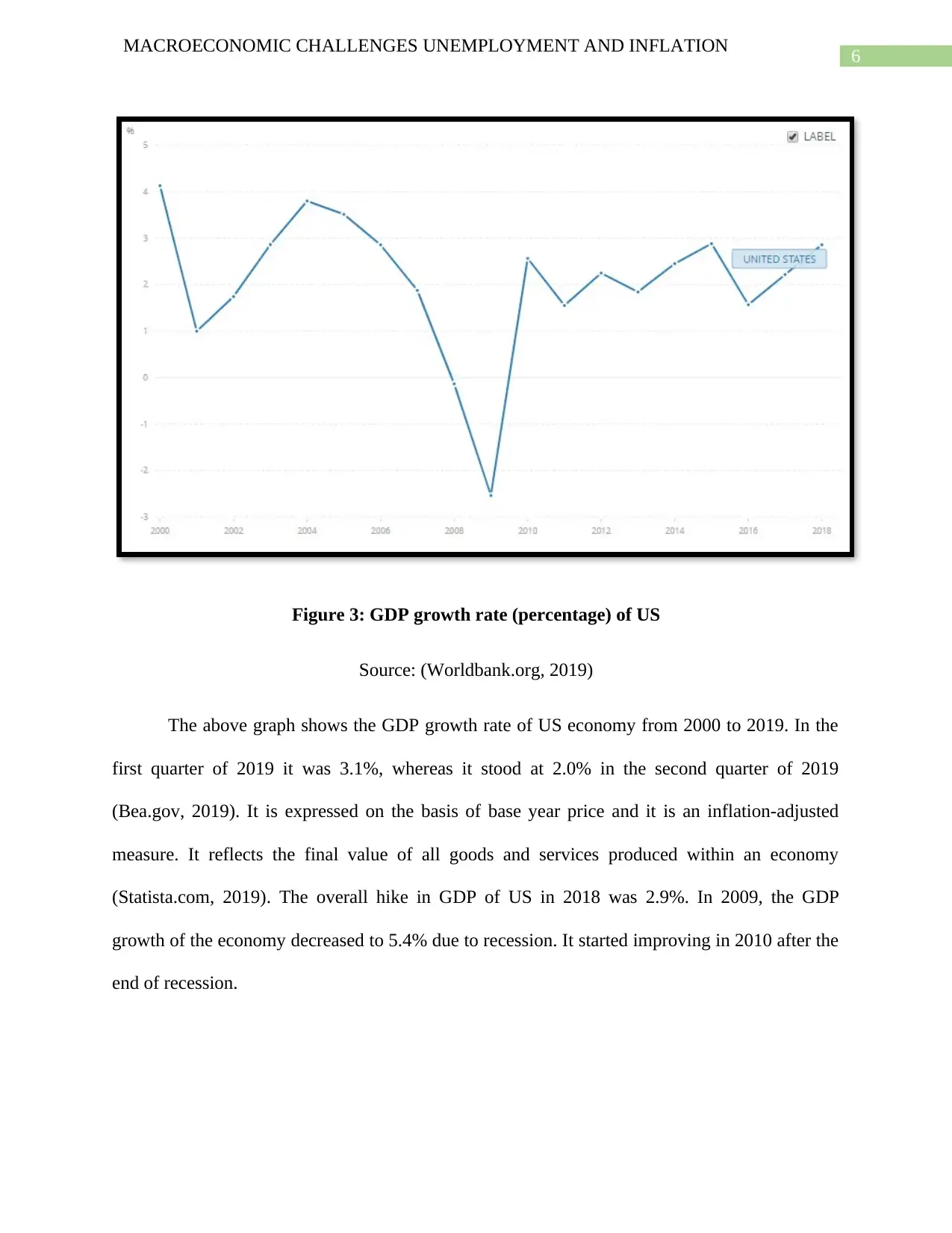
6
MACROECONOMIC CHALLENGES UNEMPLOYMENT AND INFLATION
Figure 3: GDP growth rate (percentage) of US
Source: (Worldbank.org, 2019)
The above graph shows the GDP growth rate of US economy from 2000 to 2019. In the
first quarter of 2019 it was 3.1%, whereas it stood at 2.0% in the second quarter of 2019
(Bea.gov, 2019). It is expressed on the basis of base year price and it is an inflation-adjusted
measure. It reflects the final value of all goods and services produced within an economy
(Statista.com, 2019). The overall hike in GDP of US in 2018 was 2.9%. In 2009, the GDP
growth of the economy decreased to 5.4% due to recession. It started improving in 2010 after the
end of recession.
MACROECONOMIC CHALLENGES UNEMPLOYMENT AND INFLATION
Figure 3: GDP growth rate (percentage) of US
Source: (Worldbank.org, 2019)
The above graph shows the GDP growth rate of US economy from 2000 to 2019. In the
first quarter of 2019 it was 3.1%, whereas it stood at 2.0% in the second quarter of 2019
(Bea.gov, 2019). It is expressed on the basis of base year price and it is an inflation-adjusted
measure. It reflects the final value of all goods and services produced within an economy
(Statista.com, 2019). The overall hike in GDP of US in 2018 was 2.9%. In 2009, the GDP
growth of the economy decreased to 5.4% due to recession. It started improving in 2010 after the
end of recession.
Paraphrase This Document
Need a fresh take? Get an instant paraphrase of this document with our AI Paraphraser
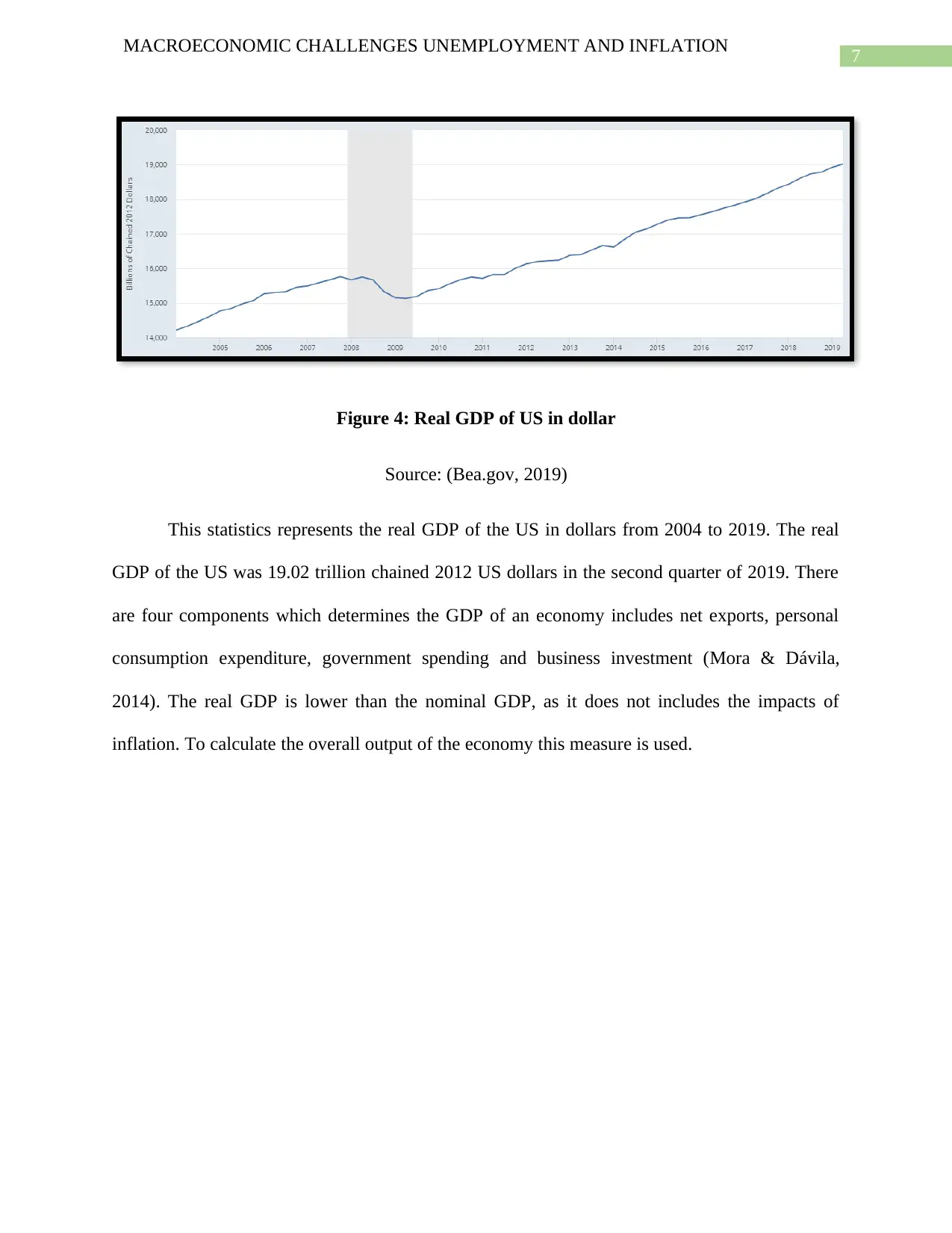
7
MACROECONOMIC CHALLENGES UNEMPLOYMENT AND INFLATION
Figure 4: Real GDP of US in dollar
Source: (Bea.gov, 2019)
This statistics represents the real GDP of the US in dollars from 2004 to 2019. The real
GDP of the US was 19.02 trillion chained 2012 US dollars in the second quarter of 2019. There
are four components which determines the GDP of an economy includes net exports, personal
consumption expenditure, government spending and business investment (Mora & Dávila,
2014). The real GDP is lower than the nominal GDP, as it does not includes the impacts of
inflation. To calculate the overall output of the economy this measure is used.
MACROECONOMIC CHALLENGES UNEMPLOYMENT AND INFLATION
Figure 4: Real GDP of US in dollar
Source: (Bea.gov, 2019)
This statistics represents the real GDP of the US in dollars from 2004 to 2019. The real
GDP of the US was 19.02 trillion chained 2012 US dollars in the second quarter of 2019. There
are four components which determines the GDP of an economy includes net exports, personal
consumption expenditure, government spending and business investment (Mora & Dávila,
2014). The real GDP is lower than the nominal GDP, as it does not includes the impacts of
inflation. To calculate the overall output of the economy this measure is used.
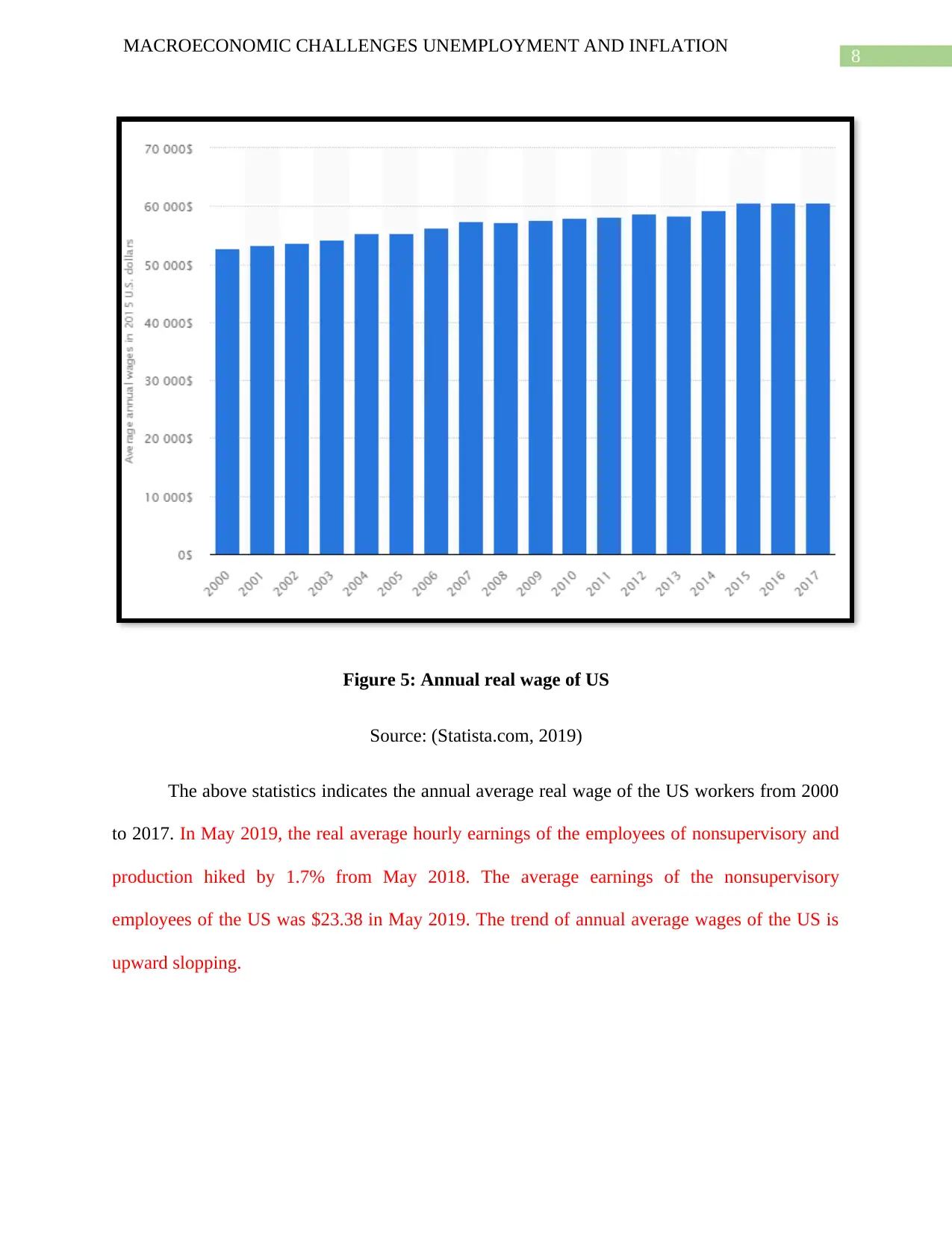
8
MACROECONOMIC CHALLENGES UNEMPLOYMENT AND INFLATION
Figure 5: Annual real wage of US
Source: (Statista.com, 2019)
The above statistics indicates the annual average real wage of the US workers from 2000
to 2017. In May 2019, the real average hourly earnings of the employees of nonsupervisory and
production hiked by 1.7% from May 2018. The average earnings of the nonsupervisory
employees of the US was $23.38 in May 2019. The trend of annual average wages of the US is
upward slopping.
MACROECONOMIC CHALLENGES UNEMPLOYMENT AND INFLATION
Figure 5: Annual real wage of US
Source: (Statista.com, 2019)
The above statistics indicates the annual average real wage of the US workers from 2000
to 2017. In May 2019, the real average hourly earnings of the employees of nonsupervisory and
production hiked by 1.7% from May 2018. The average earnings of the nonsupervisory
employees of the US was $23.38 in May 2019. The trend of annual average wages of the US is
upward slopping.
⊘ This is a preview!⊘
Do you want full access?
Subscribe today to unlock all pages.

Trusted by 1+ million students worldwide
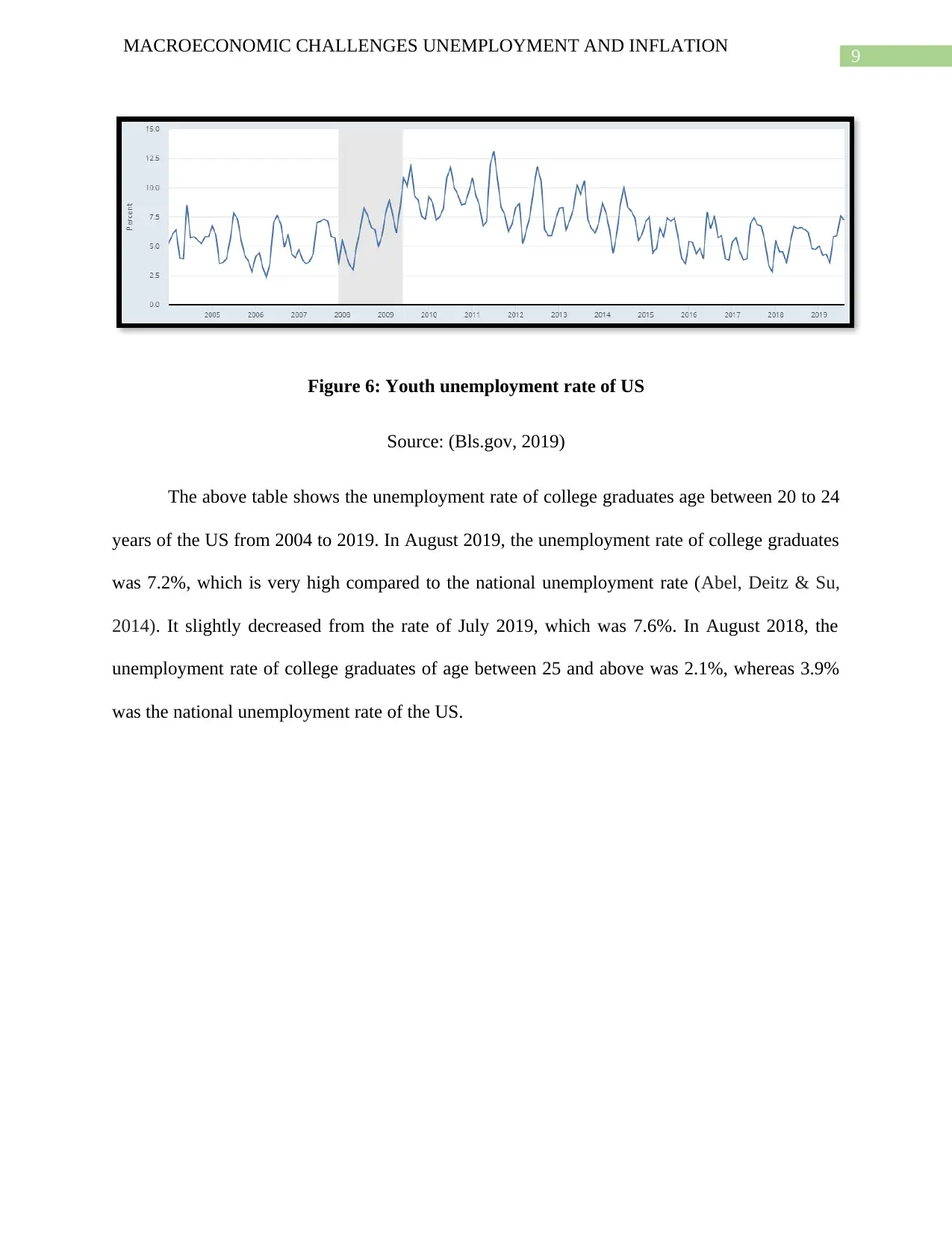
9
MACROECONOMIC CHALLENGES UNEMPLOYMENT AND INFLATION
Figure 6: Youth unemployment rate of US
Source: (Bls.gov, 2019)
The above table shows the unemployment rate of college graduates age between 20 to 24
years of the US from 2004 to 2019. In August 2019, the unemployment rate of college graduates
was 7.2%, which is very high compared to the national unemployment rate (Abel, Deitz & Su,
2014). It slightly decreased from the rate of July 2019, which was 7.6%. In August 2018, the
unemployment rate of college graduates of age between 25 and above was 2.1%, whereas 3.9%
was the national unemployment rate of the US.
MACROECONOMIC CHALLENGES UNEMPLOYMENT AND INFLATION
Figure 6: Youth unemployment rate of US
Source: (Bls.gov, 2019)
The above table shows the unemployment rate of college graduates age between 20 to 24
years of the US from 2004 to 2019. In August 2019, the unemployment rate of college graduates
was 7.2%, which is very high compared to the national unemployment rate (Abel, Deitz & Su,
2014). It slightly decreased from the rate of July 2019, which was 7.6%. In August 2018, the
unemployment rate of college graduates of age between 25 and above was 2.1%, whereas 3.9%
was the national unemployment rate of the US.
Paraphrase This Document
Need a fresh take? Get an instant paraphrase of this document with our AI Paraphraser
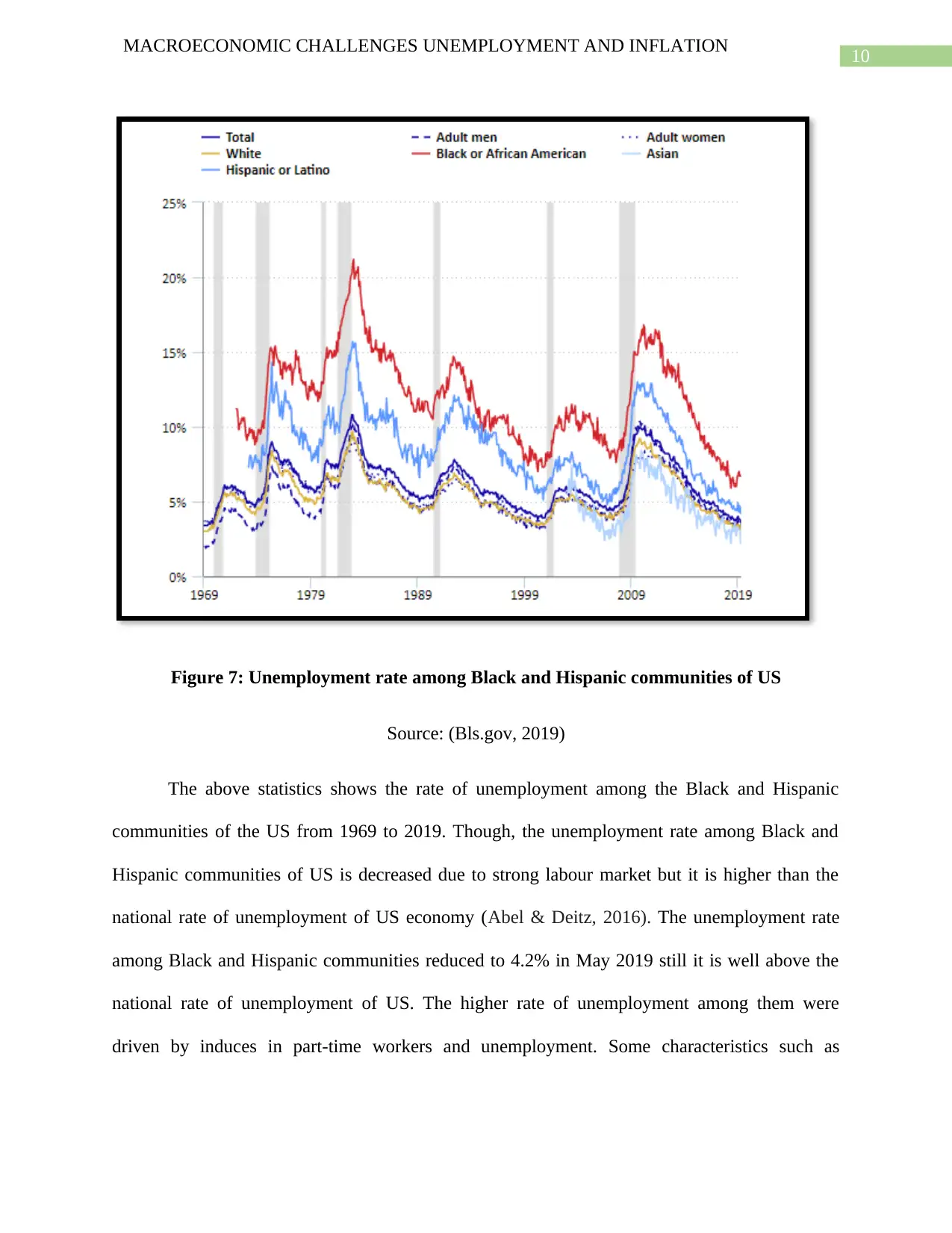
10
MACROECONOMIC CHALLENGES UNEMPLOYMENT AND INFLATION
Figure 7: Unemployment rate among Black and Hispanic communities of US
Source: (Bls.gov, 2019)
The above statistics shows the rate of unemployment among the Black and Hispanic
communities of the US from 1969 to 2019. Though, the unemployment rate among Black and
Hispanic communities of US is decreased due to strong labour market but it is higher than the
national rate of unemployment of US economy (Abel & Deitz, 2016). The unemployment rate
among Black and Hispanic communities reduced to 4.2% in May 2019 still it is well above the
national rate of unemployment of US. The higher rate of unemployment among them were
driven by induces in part-time workers and unemployment. Some characteristics such as
MACROECONOMIC CHALLENGES UNEMPLOYMENT AND INFLATION
Figure 7: Unemployment rate among Black and Hispanic communities of US
Source: (Bls.gov, 2019)
The above statistics shows the rate of unemployment among the Black and Hispanic
communities of the US from 1969 to 2019. Though, the unemployment rate among Black and
Hispanic communities of US is decreased due to strong labour market but it is higher than the
national rate of unemployment of US economy (Abel & Deitz, 2016). The unemployment rate
among Black and Hispanic communities reduced to 4.2% in May 2019 still it is well above the
national rate of unemployment of US. The higher rate of unemployment among them were
driven by induces in part-time workers and unemployment. Some characteristics such as
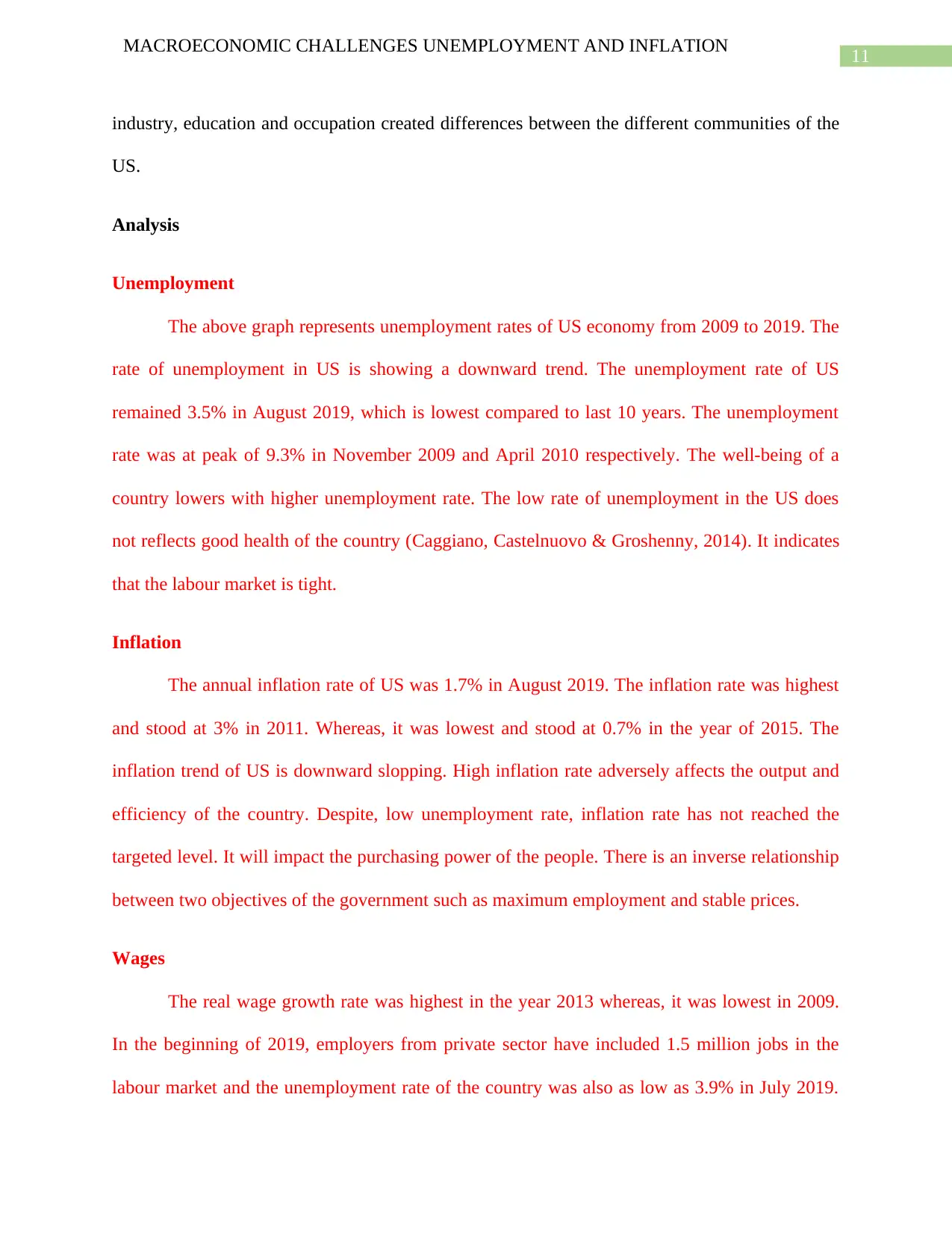
11
MACROECONOMIC CHALLENGES UNEMPLOYMENT AND INFLATION
industry, education and occupation created differences between the different communities of the
US.
Analysis
Unemployment
The above graph represents unemployment rates of US economy from 2009 to 2019. The
rate of unemployment in US is showing a downward trend. The unemployment rate of US
remained 3.5% in August 2019, which is lowest compared to last 10 years. The unemployment
rate was at peak of 9.3% in November 2009 and April 2010 respectively. The well-being of a
country lowers with higher unemployment rate. The low rate of unemployment in the US does
not reflects good health of the country (Caggiano, Castelnuovo & Groshenny, 2014). It indicates
that the labour market is tight.
Inflation
The annual inflation rate of US was 1.7% in August 2019. The inflation rate was highest
and stood at 3% in 2011. Whereas, it was lowest and stood at 0.7% in the year of 2015. The
inflation trend of US is downward slopping. High inflation rate adversely affects the output and
efficiency of the country. Despite, low unemployment rate, inflation rate has not reached the
targeted level. It will impact the purchasing power of the people. There is an inverse relationship
between two objectives of the government such as maximum employment and stable prices.
Wages
The real wage growth rate was highest in the year 2013 whereas, it was lowest in 2009.
In the beginning of 2019, employers from private sector have included 1.5 million jobs in the
labour market and the unemployment rate of the country was also as low as 3.9% in July 2019.
MACROECONOMIC CHALLENGES UNEMPLOYMENT AND INFLATION
industry, education and occupation created differences between the different communities of the
US.
Analysis
Unemployment
The above graph represents unemployment rates of US economy from 2009 to 2019. The
rate of unemployment in US is showing a downward trend. The unemployment rate of US
remained 3.5% in August 2019, which is lowest compared to last 10 years. The unemployment
rate was at peak of 9.3% in November 2009 and April 2010 respectively. The well-being of a
country lowers with higher unemployment rate. The low rate of unemployment in the US does
not reflects good health of the country (Caggiano, Castelnuovo & Groshenny, 2014). It indicates
that the labour market is tight.
Inflation
The annual inflation rate of US was 1.7% in August 2019. The inflation rate was highest
and stood at 3% in 2011. Whereas, it was lowest and stood at 0.7% in the year of 2015. The
inflation trend of US is downward slopping. High inflation rate adversely affects the output and
efficiency of the country. Despite, low unemployment rate, inflation rate has not reached the
targeted level. It will impact the purchasing power of the people. There is an inverse relationship
between two objectives of the government such as maximum employment and stable prices.
Wages
The real wage growth rate was highest in the year 2013 whereas, it was lowest in 2009.
In the beginning of 2019, employers from private sector have included 1.5 million jobs in the
labour market and the unemployment rate of the country was also as low as 3.9% in July 2019.
⊘ This is a preview!⊘
Do you want full access?
Subscribe today to unlock all pages.

Trusted by 1+ million students worldwide
1 out of 17
Related Documents
Your All-in-One AI-Powered Toolkit for Academic Success.
+13062052269
info@desklib.com
Available 24*7 on WhatsApp / Email
![[object Object]](/_next/static/media/star-bottom.7253800d.svg)
Unlock your academic potential
Copyright © 2020–2025 A2Z Services. All Rights Reserved. Developed and managed by ZUCOL.





